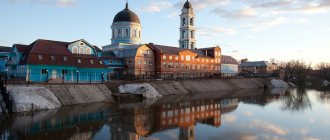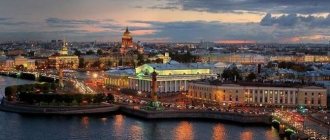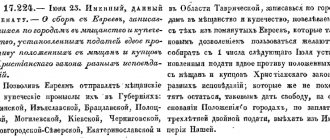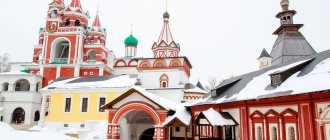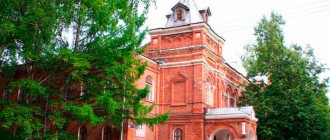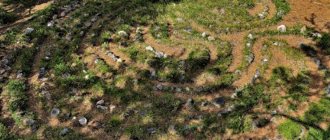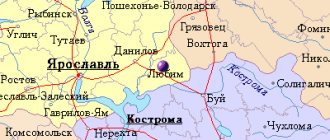For the Murmansk Shipping Company steamship, see SS Rzhev.
City of regional significance in the Tver region, Russia
| Rzhev Rzhev | |
| City of regional significance[1] | |
| Types of Rzhev | |
| Flag Coat of arms | |
| Location of Rzhev | |
| Rzhev Location of Rzhev Show map of Russia Rzhev Rzhev (Tver region) Show map of Tver region | |
| Coordinates: 56°15′N 34°19'E / 56.250°N Latitude 34.317°E / 56.250; 34.317Coordinates: 56°15′N 34°19'E / 56.250°N Latitude 34.317°E / 56.250; 34.317 | |
| A country | Russia |
| Federal subject | Tver region[1] |
| First mention | 1216 |
| Government | |
| • Head of Administration | Alexander Shcheteshin |
| Height | 190 m (620 ft) |
| population (2010 Census)[2] | |
| • General | 61,982 |
| • Evaluate (2018)[3] | 59,422 (-4.1%) |
| • Classify | 257th in 2010 |
| Administrative status | |
| • Subordinate | Rzhev Okrug[1] |
| • Capital from | Rzhevsky district[4], Rzhevsky district[1] |
| Municipal status | |
| • Urban district | Rzhev city district[5] |
| • Capital from | Rzhev urban district[5], Rzhevsky municipal district[5] |
| Timezone | UTC + 3 (MSK [6]) |
| Postal code(s)[7] | 172380 |
| Dial code(s) | +7 48232 |
| OKTMO I WOULD | 28745000001 |
| Web site | www.rzhevgorod.RU |
Rzhev
(Russian: Rzhev, IPA: [ˈRʐɛf]) is a town in Tver Oblast, Russia, located 49 kilometers (30 mi) southwest of Staritsa and 126 kilometers (78 mi) of Tver, at the highway and railway junction Moscow and Riga. This is the highest city located on the Volga River. Population: 61,982 (2010 Census);[2]63,729 (2002 Census);[8]69,808 (1989 Census).[9]
Story
View of Rzhev before the October Revolution;
photo Sergey Prokudin-Gorsky Rzhev was founded in the Middle Ages and rivals Toropets as the oldest city in the region. Rzhevites usually note that their city is mentioned in the Novgorod laws back in 1019. Their neighbors from Toropets, on the other hand, give more credence to the first mention of Rzhev in a large chronicle under 1216, when it was in the possession of Mstislav the Bold, Prince of Toropets. Whatever the truth, it is clear that medieval Rzhev was fiercely contested by three regional powers—the Novgorod Republic, the Principality of Smolensk, and the Grand Duchy of Vladimir-Suzdal. After the Mongol invasion, Rzhev passed to a side branch of the Smolensk dynasty, which made the city its capital. Later, the princes divided the city into two parts, which are still called the Side of Prince Dmitry and the Side of Prince Theodore. In the mid-14th century, they had difficulty repelling attacks from Algirdas of Lithuania and the Grand Dukes of Tver, who bought all the villages around the city. Eventually they left for Moscow, where their descendants ( Rzhevsky
family) have become comic characters in many jokes. Meanwhile, the city was briefly occupied by Tver, Poland-Lithuania, and finally the Grand Duchy of Moscow.[10]
During the administrative reform carried out in 1708 by Peter the Great, Rzhev entered the Ingermanland Governorate (from 1710 - St. Petersburg Governorate), and in 1727 the Novgorod Governorate broke away. In 1775, the Tver governorship was formed from lands that previously belonged to Moscow and the Novgorod province, and Rzhev was transferred to the Tver governorship, which in 1796 was transformed into the Tver province. In 1775, Rzhevsky district was created with its center in Rzhev.[11] In the 18th century, local merchants, mainly from the Old Believer Confession, brought the city a great measure of prosperity.
On July 12, 1929, provinces and districts were abolished, and the Rzhevsky district was formed with the administrative center in the city of Rzhev. It belonged to the Rzhev district of the Western region.[12][13] On August 1, 1930, the districts were abolished, and the districts were subordinated directly to the region. On January 29, 1935, the Kalinin region was created, and Rzhev was transferred to the Kalinin region.[11][12] In 1990, the Kalinin region was renamed the Tver region.[13]
During World War II, Rzhev was occupied by German troops from October 14, 1941 to March 3, 1943. More than a sixth of the population was sent to forced labor in Germany during the Nazi occupation, and approximately nine thousand residents were shot, starved, or tortured until death in a concentration camp set up in the city center. During this occupation, major fighting took place between the Red Army and German troops in the area of Rzhev, Sychevka and Vyazma. These operations, which resulted in heavy casualties among civilians and military personnel, are usually called the Battles of Rzhev and almost completely destroyed the city's population. Almost no old architecture from these battles has survived.[14]In honor of the people who died in the war, a monument was unveiled in Rzhev on June 30, 2022. Vladimir Putin and Alexander Lukashenko attended the unveiling, leaving roses at the base of the statue.[15]
A short walk around Rzhev
Having driven around the city, we stopped at Sovetskaya Square . It is traditional for many Russian cities: a monument to Lenin , attractions.
Monument to Lenin on Sovetskaya Square Stela “Rzhev - City of Military Glory”
Nearby are ancient houses that now house government agencies.
Branch for the Rzhevsky district of the Federal Treasury Department for the Tver region
Police Department
Not far from Sovetskaya Square there is a park by V.V. Gratsinsky (1891-1918), laid out in honor of the first military commissar of Rzhev district. There are many monuments dedicated to Soviet history.
Park named after V.V. Gratsinsky
Monument to executed underground fighters
Gracinsky's grave still bears traces of shells.
Monument at the grave of V.V. Gratsinsky
Monument at the grave of V.V. Gratsinsky
Monument at the grave of V.V. Gratsinsky
From Gratsinsky’s grave there is an Alley of Heroes of the Soviet Union, participants in the Battle of Rzhev . Pedestals with names were chosen by pigeons, which are absolutely not afraid of people.
Alley of Heroes of the Soviet Union - participants in the Battle of Rzhev
Pigeons
Having passed through the park, we came out onto a high slope. Below, the Volga winds like a picturesque ribbon. Rzhev is the first city on the Volga; it is located 200 km from its source.
"Old" bridge and the Volga river Volga and "New" bridge
Volga and the Church of the Icon of the Mother of God of Okovets in Rzhev
There are also many monuments dedicated to the Great Patriotic War*.
* At first I wanted to write “dedicated to the last war.” But, alas, that bloody war was not the last...
Monument - ZIS-2 anti-tank gun
A little further away is the Obelisk to the Heroes of the Great Patriotic War , erected in 1963, in honor of the 20th anniversary of the end of the Battle of Rzhev.
Bridge and obelisk in honor of WWII heroes
The newlyweds' permanent locks are on the pedestrian bridge.
Locks
Obelisk to the heroes of WWII
Bas-relief on the pedestal of the obelisk to the heroes of the Second World War
Next to the Obelisk is the eternal flame at the Tomb of the Unknown Soldier .
Tomb of the Unknown Soldier
On the other side of Gratsinsky Park is the red Church of the New Martyrs and Confessors of Russia , founded on May 8, 1995; Services have been held here since 2004.
Church of the New Martyrs and Confessors of Russia
On the other bank of the Volga there are several more interesting monuments. Noteworthy is the majestic Cathedral of the Icon of the Mother of God of Okovets, built in 1821, with the thrones of John the Baptist and Nil Stolobensky.
Cathedral of the Icon of the Mother of God Okovetskaya
Not far from it you can see the Memorial Complex to fallen internationalist soldiers and participants in other local conflicts .
Memorial complex to fallen internationalist soldiers and participants in other local conflicts
Control machine in the Memorial complex to fallen internationalist soldiers and participants in other local conflicts
After admiring the city, we hit the road.
Economy
Rzhev produces most of the cranes used in the construction of apartment buildings and shopping centers in Moscow.
Transport
The railway connecting Moscow and Riga passes through Rzhev. Another railway connection is Torzhok with Vyazma via Rzhev, crossing it from north to south. There is a passenger rail service.
The M9 Highway connecting Moscow with Riga also passes through Rzhev. Two other roads connect Rzhev with Tver via Staritsa and with Ostashkov via Selizharovo. There are also local roads along which buses depart from Rzhev.
The Volga is navigable, but there is no passenger navigation.
When is it better to attack: the logic of war
The battle for Rzhev became one of the most controversial, classified and even mysterious episodes of the Great Patriotic War. Only by chance and the power of A. Tvardovsky’s talent did the whole country learn the words “I was killed near Rzhev.” What happened in the area of the Rzhev salient? It would seem that this is not the time to attack: in the south, German units are rushing to the oil fields of the Caucasus, in the large bend of the Don on the far approaches to Stalingrad a tank battle is dying out. If somewhere the enemy is not conducting offensive actions, then it’s time to sit quietly and improve your defense.
Map of the battle for Rzhev
Source: upload.wikimedia.org
However, war has a completely different logic. Firstly, now that it is possible to get acquainted with the documents of both sides, the thesis “does not conduct offensive actions” becomes completely unconvincing. On the one hand, the strongest Army Group Center did not receive tasks as part of the Blau plan of the Wehrmacht's summer offensive. Here the Germans simulated preparations for an attack on Moscow - the so-called Operation Kremlin. It would be a big mistake to think that instead of this imitation, the Germans could not have carried out an offensive of limited scale, but with dire consequences for the Soviet troops.
The commander of Army Group Center, von Kluge, chose the Sukhinichi ledge, formed during the Soviet winter offensive of 1941-1942, as the target of capture. The name “Kremlin” would have been too strong for such an offensive, and the operation was codenamed “Smerch” (Wilberwind). Initially, the start of “Smerch” was scheduled for August 7-9, 1942. The plan provided for strikes in converging directions, typical of the German military school, with the aim of encircling Soviet troops in a bulge. A kind of Kursk Bulge of 1943, but on a reduced scale. The staff worked on this plan for several months. If Army Group Center had become the main player in the 1942 campaign, then the attack on Moscow would have begun with the cutting off of the Sukhinichi ledge.
Secondly, the Soviet General Staff and the headquarters of the Kalinin and Western fronts did not know all this at that time, but were preparing for an offensive with their own goals. The tasks of the Kalinin and Western Fronts were formulated in the Directive of the Supreme Command Headquarters No. 170514 of July 16, 1942. It said, in particular: “...with the main forces to capture the city of Rzhev, crossing the river. Volga and the railway junction." The Germans, holding Rzhev, controlled the highways and railways on the flank of Army Group Center. To push the Germans further from Moscow, it was necessary to effectively supply the Kalinin Front, which hung over the flank of Army Group Center. Without Rzhev this would have been impossible. In addition, by knocking the Germans out of their positions near Rzhev, the Red Army deprived the enemy of an advantageous springboard for an attack on Moscow. Now we know that Moscow was not in the Wehrmacht’s immediate plans. It is not difficult to predict how the situation would turn out if Blau were successful. Moscow would undoubtedly become one of the next targets of the German war machine.
Soviet soldiers in the battles for Rzhev
Source: pinterest.ru
Returning to the end of July and the first days of August 1942, it should be said that the Soviet offensive was unexpected for the Germans. At least in terms of the strength of the blows and the effectiveness of his preparation. Despite the overall difficult situation with ammunition in 1942, significant resources were allocated for the attack on Rzhev, primarily artillery (Stalingrad, as a maneuver battle, absorbed mainly tank reserves).
By the end of the first day of the offensive, the troops of the 30th Army broke through the defenses of the 256th and 87th Infantry Divisions of the German VI Army Corps on a front of 9 km and to a depth of 6-7 km. There were 6 kilometers left to Rzhev. However, covering these kilometers took a month. The problem with Rzhev and other positional battles was that if it was not possible to immediately collapse the front and bring tanks into the breakthrough, the enemy pulled up reserves to the attacked area and built a new line of defense. The mechanism for the development of events was absolutely identical to the battles of the First World War, which took place not due to the stupidity of the participants, but due to objective problems in crushing a strong and capable enemy. When neither side has a decisive advantage in forces and means.
Culture and recreation
In Rzhev there are 15 cultural heritage monuments of federal significance, as well as 72 objects classified as cultural and historical heritage of local significance. Federal monuments include the Church of St. John the Baptist (also known as the Okovets Church), built in the 19th century, monuments to soldiers and civilians killed in World War II, and a number of archaeological sites.[16]
There is a local history museum in Rzhev.[17] In 2013, the Joseph-Stalin Museum was opened in the building where Joseph Stalin spent one night in 1943 inspecting troops. As of 2015[Update], the museum did not have regular opening hours and was open by appointment only to maintain a low profile.[18]
The Germans have to change all their plans!
Events developed in the offensive zone of the Western Front according to a similar scenario. Already at 13:50 on the first day of the offensive, units of the 251st Infantry Division of the 20th Army broke into Pogoreloe Gorodishche. As a result of fierce fighting, which turned into hand-to-hand combat, the garrison of Pogorely Gorodishche, while trying to break through the bridge on the Derzha River at the southwestern outskirts of the city, was partly destroyed and partly captured. Subsequently, the operation will receive the name “Pogorelo-Gorodishchenskaya” after the name of this city liberated by the 20th Army. The Rzhev area was then the only place on the Soviet-German front where the Red Army advanced and liberated the territory.
In moments of calm
Source: pinterest.ru
As a result of two days of operation, the troops of the 20th Army broke through the enemy’s defenses on a front of 18 km and to a depth of 30 km and advanced units reached the approaches to the Vazuza and Gzhat rivers. Here the Soviet offensive was stopped by hastily gathering reserves. Where did they come from? The Germans abandoned the offensive on the northern face of the Sukhinichi ledge. “Smerch” in its original form is cancelled, three tank divisions are quickly moving towards the 20th Army. The front is gradually recovering. The last success on the Western Front was the destruction of a large German stronghold near the village of Karmanovo on August 23, 1942. One of the reasons for the loss of momentum was also the heavy rains that poured in on August 7, which significantly hampered the supply of advanced units along washed-out roads.
On August 26, 1942, the commander of the Kalinin Front, I.S. Konev, was appointed commander of the Western Front, replacing G.K. Zhukov, who assumed the post of Deputy Supreme Commander-in-Chief and hastily left for Stalingrad. Lieutenant General M.A. Purkaev was appointed commander of the Kalinin Front. However, I.S. Konev did not leave the battle for Rzhev.
Recommendations
Okovets Church View of Rzhev
Notes
- ^ a b c d f f
Law No. 34-ZO. - ^ a b
Federal State Statistics Service of Russia (2011).
“All-Russian Population Census 2010. Volume 1" [All-Russian Population Census 2010, vol. 1]. All-Russian Population Census 2010 [All-Russian Population Census 2010]
(in Russian). Federal State Statistics Service. - "26. The size of the permanent population of the Russian Federation by municipalities as of January 1, 2022.” Federal State Statistics Service. Retrieved January 23, 2022.
- ^ a b
State Committee of the Russian Federation on Statistics.
Committee of the Russian Federation for Standardization, Metrology and Certification. No. OK 019-95 January 1, 1997 “All-Russian classifier of objects of administrative-territorial division. Code 28 248”, Ed. changes No. 278 / 2015 dated January 1, 2016. (State Committee of the Russian Federation on Statistics. Committee of the Russian Federation on Standardization, Metrology and Certification. No. OK 019-95 January 1, 1997 Russian Classification of Administrative Objects (OKATO). Code 28 248
As amended by Amendment No. 278/2015 dated January 1, 2016). - ^ a b c d
Law No. 4-ZO. - "On the calculation of time." Official Internet portal of legal information
(in Russian). June 3, 2011. Retrieved January 19, 2022. - Post office. Information and computing center of OASU RPO. ( Post office
).
Search for postal facilities ( Search for postal facilities
) (in Russian) - Federal State Statistics Service of Russia (May 21, 2004). “The population of Russia, the constituent entities of the Russian Federation as part of federal districts, urban settlements, urban settlements, settlements, settlements is 3 thousand or more people” [Population of Russia, its federal districts, constituent entities of the federation, districts, urban settlements, rural settlements - administrative centers, rural settlements with a population of more than 3000 people] (XLS). All-Russian Population Census of 2002 [All-Russian Population Census of 2002]
(in Russian). - “All-Union Population Census of 1989. The actual population of the union and autonomous republics, autonomous regions and districts, territories, regions, urban settlements and villages of Novgorod and Lithuania: Border situations of the 13th-15th centuries” (in Russian). Moscow State University. Retrieved May 29, 2015.
- ^ a b
Information on changes in the administrative-territorial division of the Tver region - Kalinin region (in Russian). Archives of Russia. Archived from the original on February 29, 2012. Retrieved March 1, 2014. - ^ a b
Vorobyov, M. V. (1993). G. V. Tufanova (ed.). Administrative-territorial division of the Smolensk region (in Russian). State Archive of the Smolensk Region. pp. 118–133. - ^ a b
Malygin, P. D.;
Smirnov, S. N. (2007). History of the administrative-territorial division of the Tver Region
(PDF). Tver. pp. 14–15. OCLC 540329541. - Brumfield, W. (24 January 2022). "Rzhev: Provincial beauty, resurrected from the ashes of war." Russia is beyond the headlines. Retrieved January 29, 2022.
- “The Rzhev Memorial to the Soviet Soldier will open on June 30.”
- Monuments of history and culture of the peoples of the Russian Federation (in Russian). Ministry of Culture of Russia. Retrieved June 2, 2016.
- Rzhev Museum of Local Lore (in Russian). Russian Network of Cultural Heritage. Retrieved June 14, 2015.
- Kots, Alexander; Dmitry Steshin (June 10, 2015). In Rzhev they want, but are afraid to open a museum-hut of Stalin (in Russian). TVNZ. Retrieved June 14, 2015.
- The seed for safe communities in Russia has been sown, and the future will show how it will grow Archived October 6, 2011 Wayback Machine
Sights of Rzhev
- Memorial military cemetery: Rzhev, Ostashkovskoe highway
- Izba-museum of J.V. Stalin: Khoroshevo village, tel. 8 (48232) 79 203
- Steam locomotive - a monument to Rzhev railway workers: st. Mira, 8
- Museum of Military History of Rzhev: Krasnoarmeyskaya embankment, 26
- Rzhev Museum of Local Lore: Krasnoarmeyskaya embankment, 24a; Opening hours: from 11.00 to 18.00, except Monday (on Tuesday only excursion service)
- Rzhev branch of the Central Museum of the October Railway: st. Oktyabrskaya, 74/21
- Church of the Okovets Icon of the Mother of God: st. Marata, 2
- Church of the New Martyrs and Confessors of Russia: st. Lenina, 2
- Ascension Cathedral: Toropets tract
- Bell tower of the Church of the Life-Giving Trinity: st. Smolnaya
- Church of the Intercession: st. Kalinina, 62
© Website “On the Roads of the Middle Way”, 2009-2021. Copying and reprinting of any materials and photographs from the site anashina.com in electronic publications and printed publications is prohibited.


